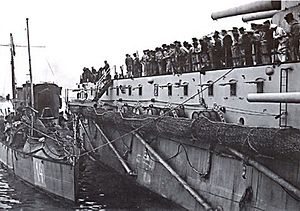|
SMS Kígyó
SMS Kígyó was a torpedo boat of the Austro-Hungarian Navy (KuK). In 1910, she was renamed Torpedoboot 14. Design and constructionThe Cobra-class torpedo boats were ordered in Great Britain for the Austro-Hungarian Navy, their design being based on the SMS Viper. The ship was built at the Yarrow shipyard in London.[2] The torpedo boat was laid down in 1898, was launched on 11 April 1899, and commissioned on 31 January 1900.[3] Technical dataThe ship was a small coastal torpedo boat.[3] The length of the design was 46.6 meters (152 ft 11 in) (45.9 m, 150 ft 7 in between the perpendiculars), the width was 4.6 m (15 ft 1 in) and the draft was 2.3 m (7 ft 7 in).[3] Her standard displacement was 115 tons, and the full displacement was 135 tons.[3][4] The ship was powered by a triple-expansion steam engine with a design power of 1,800 horsepower (1,300 kW) (maximum 2,000 hp, 1,500 kW), steam supplied by two Yarrow boilers.[3] The single-screw propulsion system allowed to reach a speed of 24 knots (44 km/h; 28 mph).[3] She also held a stock of 30 tons of coal. She was equipped with three 450 mm single torpedo tubes.[2] The artillery armament consisted of two single 47 mm L/33 Hotchkiss on-board cannons. Operational historyIn 1910, on the basis of the ordinance on the normalization of names, Kígyó was renamed Torpedoboot 14. In 1913, she underwent a major renovation, and in 1914 she was adapted to act as a seaplane tender, one torpedo tube being removed to be replaced by a catapult.[3] Due to the collapse of the Habsburg monarchy on 1 November 1918, the KuK flag was hoisted on the vessel for the last time.[5] As a result of the Treaty of Trianon, the ship was awarded to Great Britain.[2][6] The vessel was scrapped in 1920.[3] References
|
||||||||||||||||||||||||||||||||||||||||||
